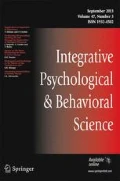Abstract
The Quality-Location Phenomenon is defined by the previous research of Lawicka (1964 and 1969) in which dogs easily learn go/no-go tasks to differences in stimulus quality and go-left/go-right tasks to differences in stimulus location whereas the opposite pairings of tasks and stimulus attributes are difficult to learn. The Lawicka-Konorski explanation in terms of drive differentiation and response selection is described, and a new hypothesis, the Quality-Location Hypothesis, is offered. This hypothesis states that the quality of a stimulus best serves as a cue for the quality of a response, whereas the location of a stimulus best serves as a cue for the location of a response. The evidence for the hypothesis is reviewed, and experimental considerations for its evaluation are mentioned.
Similar content being viewed by others
References
Bitterman, M. E., Calvin, A. D., and Elam, C. B. Perceptual differentiation in the course of nondifferential reinforcement.Journal of Comparative and Physiological Psychology, 1953,46, 393–397.
Bitterman, M. E., and McConnell, J. V. The role of set in successive discrimination.American Journal of Psychology, 1954,67, 129–132.
Bitterman, M. E., and Wodinsky, J. Simultaneous and successive discrimination.Psychological Review, 1953,60, 371–376.
Burdick, C. K. The effect of behavioral paradigm on auditory discrimination learning: A literature review.The Journal of Auditory Research, 1979,19, 59–82.
Burdick, C. K. Auditory discrimination learning by the chinchilla: Comparison of go/no-go and two-choice procedures.The Journal of Auditory Research, 1980,20, 1–29.
Cowey, A. Discrimination. In L. Weiskrantz (Ed.),Analysis of Behavioral Change. New York: Harper and Row, 1968.
Dobrzecka, C., and Konorski, J. Qualitative versus directional cues in differential conditioning. I. Left leg-right leg differentiation to cues of a mixed character.Acta Biologica Experimentalis, 1967,27, 163–168.
Dobrzecka, C., and Konorski, J. Qualitative versus directional cues in differential conditioning. IV. Left leg-right leg differentiation to nondirectional cues.Acta Biologica Experimentalis, 1968,28, 61–69.
Dobrzecka, C., Szwejkowska, G., and Konorski, J. Qualitative versus directional cues in two forms of differentiation.Science, 1966,153. 87–89.
Fellows, B. J.The Discrimination Process and Development. New York: Pergamon Press, 1968.
Garcia, J., and Koelling, R. A. Relation of cue to consequence in avoidance learning.Psychonomic Science, 1966,4, 123–124.
Harrison, J. M., Iverson, S. D., and Pratt, S. R. Control of responding by location of auditory stimuli: Adjacency of sound and response.Journal of the Experimental Analysis of Behavior, 1977,28, 243–251.
Hearst, E., and Jenkins, H. M.Sign-tracking: The Stimulus-Reinforcer Relation and Directed Action. Austin: The Psychonomic Society, 1974.
Hinde, R. A. Constraints on learning—an introduction to the problems. In R. A. Hinde and J. Stevenson-Hinde (Eds.),Constraints on Learning. New York: Academic Press, 1973.
Jenkins, H. M. Sensitivity of different response systems to stimulus-reinforcer and response-reinforcer relations. In H. Davis and H. M. B. Hurwitz (Eds.),Operant-Pavlovian Interactions. Hillsdale: Lawrence Erlbaum Associates, 1977. Johnson, H. M. Audition and habit formation in the dog.Behavior Monographs, 1913,2, (Serial No. 8).
Kimble, G. A.Hilgard and Marquis’ Conditioning and Learning. 2nd ed. New York: Appleton-Century-Crofts, 1961.
Konorski, J.Integrative Activity of the Brain. Chicago: University of Chicago Press, 1967.
Lawicka, W. The role of stimulus modality in successive discrimination and differentiation learning.Bulletin of the Academy of Polish Sciences, 1964,12, 35–38.
Lawicka, W. Differing effectiveness of auditory quality and location cues in two forms of differentiation learning.Acta Biologica Experimentalis, 1969,29, 83–92.
Loess, H. B., and Duncan, C. P. Human discrimination learning with simultaneous and successive presentation of stimuli.Journal of Experimental Psychology, 1952,44, 215–222.
LoLordo, V. M. Selective associations. In A. Dickin-son and R. A. Boakes (Eds.),Mechanisms of Learning and Motivation. Hillsdale: Lawrence Erlbaum Associates, 1979.
MacCaslin, E. F. Successive and simultaneous discrimination as a function of stimulus similarity.American Journal of Psychology, 1954,67, 308–314.
Mackintosh, N. J.The Psychology of Animal Learning. New York: Academic Press, 1974.
Meehl, P. E. On the circularity of the law of effect.Psychological Bulletin, 1950,47, 52–75.
North, A. L., and Jeeves, M. Interrelationships of successive and simultaneous discrimination.Journal of Experimental Psychology, 1956,51, 54–58.
Segal, M., and Harrison, J. M. The control of responding by auditory stimuli: Interactions between different dimensions of the stimuli.Journal of the Experimental Analysis of Behavior. 1978,30, 97–106.
Sevenster, P. Incompatibility of response and reward. In R. A. Hinde and J. Stevenson-Hinde (Eds.),Constraints on Learning. New York: Academic Press, 1973.
Shettleworth, S. J. Constraints on learning. In D. S. Lehrman, R. A. Hinde, and E. Shaw (Eds.),Advances in the Study of Behavior. New York: Academic Press, 1972.
Shettleworth, S. J. Constraints on conditioning in the writings of Konorski. In A. Dickinson and R. A. Brooks (Eds.),Mechanisms of Learning and Motivation. Hillsdale: Lawrence Erlbaum Associates, 1979.
Spence, K. W. The nature of the response in discrimination learning.Psychological Review, 1952,59, 89–93.
Stevens, S. S. On the psychophysical law.Psychological Review, 1957,64, 153–181.
Stollnitz, F. Spatial variables, observing responses, and discrimination learning sets.Psychological Review, 1965,72, 247–261.
Szwejkowska, G. Qualitative versus directional cues to differential conditioning. II. Go-no go differentiation to cues of a mixed character.Acta Biologica Experimentalis, 1967,27, 1969–1975.
Warden, C. J., and Warner, L. H. The sensory capacities and intelligence of dogs, with a report on the ability of the noted dog “Fellow” to respond to verbal stimuli.The Quarterly Review of Biology, 1928,3, 1–28.
Weise, P., and Bitterman, M. E. Response selection in discrimination learning.Psychological Review, 1951,58, 185–195.
Wodinsky, J., Varley, M. A., and Bitterman, M. E. Situational determinants of the relative difficulty of simultaneous and successive discrimination.Journal of Comparative and Physiological Psychology, 1954,47, 337–340.
Author information
Authors and Affiliations
Additional information
The preparation of this manuscript was supported by the U.S. Public Health Service under Grant NS03856 from the National Institute for Neurological and Communicative Disorders and Stroke to the Central Institute for the Deaf.
Rights and permissions
About this article
Cite this article
Miller, J.D., Bowe, C.A. Roles of the qualities and locations of stimuli and responses in simple associative learning. Pav. J. Biol. Sci. 17, 129–139 (1982). https://doi.org/10.1007/BF03001207
Issue Date:
DOI: https://doi.org/10.1007/BF03001207




